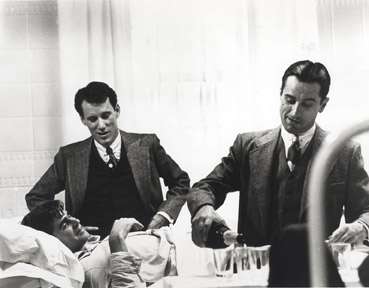Once Upon a Time in America

You see, I have a story too, Mr. Bailey. I had a friend once. A dear friend. I turned him in to save his life. He died. But he wanted it that way. Things went bad for my friend, and they went bad for me, too.
Once Upon A Time In America (also known as C'era Una Volta In America) is a 1984 crime film directed by Sergio Leone, loosely based on the novel The Hoods by Harry Grey, starring Robert De Niro, James Woods, and Elizabeth McGovern. The film centres around a Jewish-American gangster, David "Noodles" Aaronson, spanning five decades (and nearly four hours), and is framed as an elaborate flashback sequence.
Executive Meddling led to the US version of the movie being over an hour shorter, and rearranged for the scenes to be in chronological order. It ended up being a flop at the box office, but thanks largely to the original version helping popularize the concept of the "director's cut", it is now widely regarded as a cinematic masterpiece.
- All Just a Dream: Some people have theorized that most of the film is an opium-based hallucination. Even some of the actors themselves don't know.
- American Title
- Anachronic Order
- Bank Robbery
- Berserk Button: Max really, really hates being called crazy.
- Genteel Interbellum Setting
- The Danza: By coincidence, Danny Aiello as Police Chief Aiello.
- Et Tu, Brute?: Noodles finds out Max plans to hit the Federal Reserve. Realizing his best friend is going too far, Noodles tries to get the cops to arrest Max during one last smuggling job, which goes horribly wrong and kills all three of Noodles' friends...
- ...except when the story flash-forwards to The Sixties, Noodles finds that Max tricked Noodles into making the phone call. Max sent someone else to die in his place, while he changed identities becoming a powerful politician. Max ends up responsible for Cockeye and Patsy's deaths and for Noodles' decades-long guilt.
- Unless this was All Just a Dream in Noodles' head back in The Thirties...
- ...except when the story flash-forwards to The Sixties, Noodles finds that Max tricked Noodles into making the phone call. Max sent someone else to die in his place, while he changed identities becoming a powerful politician. Max ends up responsible for Cockeye and Patsy's deaths and for Noodles' decades-long guilt.
- Faking the Dead: Max
- Gainax Ending: What does that garbage truck mean? Did Max kill himself? James Woods has been dogged by such questions ever since, and even he doesn't know.
- The alternative view is that the ending between Noodles and Max was all an opium-induced dream, meaning the whole sequence in the future was a wish by Noodles that he never really betrayed his friends.
- Leave the Camera Running: Used very, very frequently. It is a Sergio Leone movie, after all.
- The Mafia
- Manipulative Bastard: Max
- Even after his death.
- Mind Screw
- One Last Job: Noodles returns to New York in The Sixties summoned by politician Bailey. Told to check the locker where his friends stored money that had gone stolen in The Thirties, Noodles finds the suitcase re-filled with cash. It's payment for a hit: Bailey/Max wants Noodles to kill him, as Bailey is facing a criminal investigation he can't evade.
- One-Scene Wonder: Jennifer Connelly as the young Deborah.
- Opium Den
- The Power of Friendship: Between Max and Noodles, with their neighborhood buddies Cockeye and Patsy as a four-man mob squad. Arguably the theme of the movie:
Noodles (speaking to his best friend Max): Today they asked us to get rid of Joe, tomorrow they ask me to get rid of you. Is that okay with you? Because it's not okay with me!
- Rape as Drama: When you think that Noodles has proven to Deborah that he's a more than just a cheap hood, too.
- Recut: The film was recut so much for its first release in America that Sergio Leone was left heartbroken because of it, and never made another film.
- He was planning on directing a film about the siege of Leningrad, and wanted to work with "America" star Robert De Niro again in the lead role for this film. Too bad he died two days before he was too have officially signed on to do the film.
- Shown Their Work: Leone spent over a year achieving the look of Manhattan in the early twentieth century.
- Silence Is Golden: Like most of Sergio Leone's films, it's pretty sparse when it comes to dialogue.
- The Cameo: Joe Pesci puts in a minor appearance as a guy employing the gang. Burt Young, of the Rocky movies, also appears at one point.
- Apparently Pesci's role was a lot bigger in Leone's script but was cut down considerably, which explains him completely disappearing in the last 3rd of the film.
- The Roaring Twenties
- The Sixties
- The Thirties: The main portion of the film is set in 1933 as Max and Noodles' operations have made them powerful mobsters. With the end of Prohibition threatening their backroom empire and driving Max into thinking bigger... like hitting the Federal Reserve Bank...
- Villain Protagonist
- Villainous BSOD: Noodles' reaction after he pours his heart out to Deborah and she turns him down flat, telling him she's going to Hollywood. Cross-pollinates with Leone's trademark Leave the Camera Running moments, as Noodles just stares for several minutes.
- What Happened to the Mouse?: Leone's original six hour cut is apparently Lost Forever, and even the four hour restored version has a couple dropped plot points, most notably Joe Pesci's character. The camera pans over to him apparently waiting for someone in a hotel lobby with ominous music playing...and he's never seen again.
- With or Without You
- Yiddish as a Second Language